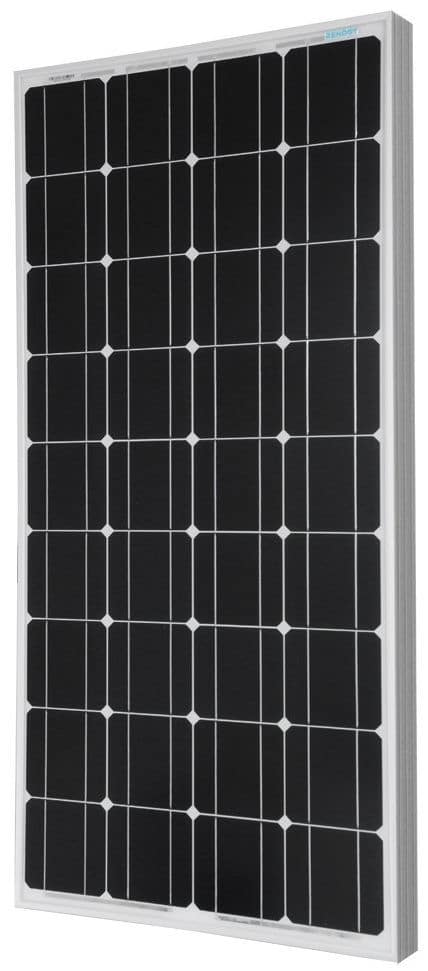
Connecting Solar Panels Together
How to Connect Solar Panels Together
![]() Connecting solar panels together is a simple and effective way of increasing your solar power capabilities. Going green is a great idea, and as the sun is our ultimate power source, it makes sense to utilize this energy to power our homes. As solar power becomes more accessible, more and more homeowners are buying photovoltaic solar panels.
Connecting solar panels together is a simple and effective way of increasing your solar power capabilities. Going green is a great idea, and as the sun is our ultimate power source, it makes sense to utilize this energy to power our homes. As solar power becomes more accessible, more and more homeowners are buying photovoltaic solar panels.
However, these photovoltaic solar panels can be very costly so buying them over time helps to spread the cost. But the problem then becomes how do we connect these extra solar panels together to increase the voltage and power output of what’s already there.
The trick here when connecting solar panels together is to choose a connection method that is going to give you the most energy efficient configuration for your particular requirements.
Connecting solar panels together can seem like a daunting task when you first start to look at how it should be done, but connecting multiple solar panels together is not that hard with a little thought. Wiring solar panels together in either parallel or series combinations to make larger arrays is an often overlooked, yet completely essential part of any well designed solar power system.
There are three basic but very different ways of connecting solar panels together and each connection method is designed for a specific purpose. For example, to produce more output voltage or to produce more current.
Solar photovoltaic panels can be electrically connected together in series to increase the voltage output, or they can be connected together in parallel to increase the output amperage. Solar pv panels can also be wired together in both series and parallel combinations to increase both the output voltage and current to produce a higher wattage array.
Whether you are connecting two or more solar panels, as long as you understand the basic principles of how connecting multiple solar panels together increases power and how each of these wiring methods works, you can easily decide on how to wire your own panels together. After all connecting solar panels together correctly can greatly improve the efficiency of your solar system.
Connecting Solar Panels Together in Series
The first method we will look at for connecting solar panels together is what’s known as “Series Wiring“. The electrical connection of solar panels in series increases the total system output voltage. Series connected solar panels are generally used when you have a grid connected inverter or charge controller that requires 24 volts or more. To series wire the panels together you connect the positive terminal to the negative terminal of each panel until you are left with a single positive and negative connection.
Solar panels in series add up or sum the voltages produced by each individual panel, giving the total output voltage of the array as shown.
Solar Panels in Series of Same Characteristics
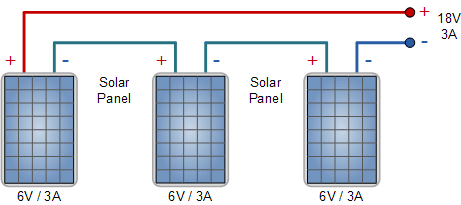
In this method ALL the solar panels are of the same type and power rating. The total voltage output becomes the sum of the voltage output of each panel. Using the same three 6 volt, 3.0 amp panels from above, we can see that when these pv panels are connected together in series, the array will produce an output voltage of 18 Volts (6 + 6 + 6) at 3.0 Amperes, giving 54 Watts (volts x amps) at full sun.
Now lets look at connecting solar panels in series with different nominal voltages but with identical current ratings.
Solar Panels in Series of Different Voltages
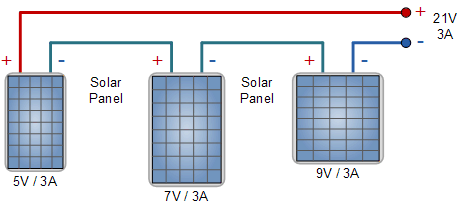
In this method all the solar panels are of different types and power rating but have a common current rating. When they are connected together in series, the array produces 21 volts at 3.0 amps, or 63 watts. Again the output amperage will remain the same as before at 3.0 amps but the voltage output jumps to 21 volts (5 + 7 + 9) .
Finally, lets look at connecting solar panels in series with completely different nominal voltages and different current ratings.
Solar Panels in Series of Different Currents
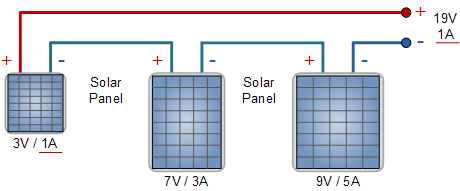
In this method all the solar panels are of different types and power rating. The individual panel voltages will add together as before, but this time the amperage will be limited to the value of the lowest panel in the series string, in this case 1 Ampere. Then the array will produce 19 Volts (3 + 7 + 9) at 1.0 Ampere only, or only 19 watts out of a possible 69 watts available reducing the arrays efficiency.
We can see that the solar panel rated at 9 volts, 5 amps, will only use one fifth or 20% of its maximum current potential reducing its efficiency and wasting money on the purchase of this solar panel. Connecting solar panels in series with different current ratings should only be used provisionally, as the solar panel with the lowest rated current determines the current output of the whole array.
Connecting Solar Panels Together in Parallel
The next method we will look at of connecting solar panels together is what’s known as “Parallel Wiring“. Connecting solar panels together in parallel is used to boost the total system current and is the reverse of the series connection. For parallel connected solar panels you connect all the positive terminals together (positive to positive) and all of the negative terminals together (negative to negative) until you are left with a single positive and negative connection to attach to your regulator and batteries.
When you connect solar panels together in parallel, the total voltage output remains the same as it would for a single panel, but the output current becomes the sum of the output of each panel as shown.
Solar Panels in Parallel of Same Characteristics
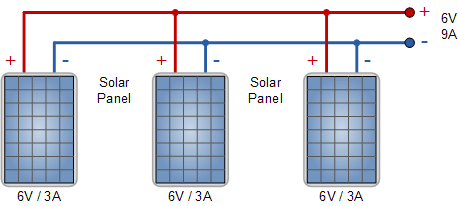
In this method ALL the solar panels are of the same type and power rating. Using the same three 6 Volt, 3.0 Amp panels as above, the total output of the panels, when connected together in parallel, the output voltage still remains at the same value of 6 volts, but the total amperage has now increased to 9.0 Amperes (3 + 3 + 3), producing 54 watts at full sun.
But what if our newly acquired solar panels are non-identical, how will this affect the other panels. We have seen that the currents add together, so no real problem there, just as long as the panel voltages are the same and the output voltage remains constant. Lets look at connecting solar panels in parallel with different nominal voltages and different current ratings.
Solar Panels in Parallel with Different Voltages and Currents
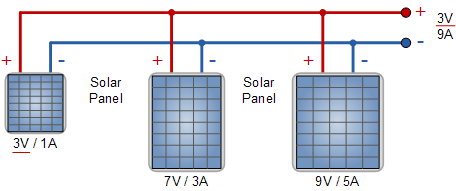
Here the parallel currents add up as before but the voltage adjusts to the lowest value, in this case 3 volts or some voltage value very close to 3 volts. Solar panels must have the same output voltage to be useful in parallel. If one panel has a higher voltage it will supply the load current to the degree that its output voltage drops to that of the lower voltage panel.
We can see that the solar panel rated at 9 volts, 5 amps, will only operate at a maximum voltage of 3 volts as its operation is being influenced by the smaller panel, reducing its efficiency and wasting money on the purchase of this higher power solar panel. Connecting solar panels in parallel with different voltage ratings is not recommended as the solar panel with the lowest rated voltage determines the voltage output of the whole array.
Then when connecting solar panels together in parallel it is important that they ALL have the same nominal voltage value, but it is not necessary that they have the same ampere value.
Connecting Solar Panels Together Summary
Connecting solar panels together to form bigger arrays is not all that complicated. How many series or parallel strings of panels you make up per array depends on what amount of voltage and current you are aiming for. If you are designing a 12 volt battery charging system than parallel wiring is perfect. If you are looking at a higher voltage grid connected system, than you’re probably going to want to go with a series or series-parallel combination depending on the number of solar panels you have.
But for a simple reference in regards to how to connect solar panels together in either parallel or series wiring configurations, just remember that parallel wiring = more amperes, and series wiring = more voltage, and with the right type and combination of solar panels you can power just about any electrical device you may have in your home.
For more information about Connecting Solar Panels Together in either series or parallel combinations, or to obtain more information about the different types of solar panels available, or to explore the advantages and disadvantages of using solar power in your home, then Click Here to order your copy from Amazon today and learn more about designing, wiring and installing off-grid photovoltaic solar electric systems in your home.





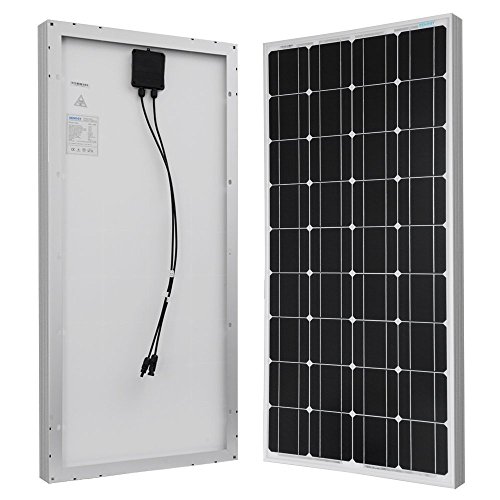





I have 20 (120Amp 12V) batteries.
I plan using a 48V inverter .
My connection is 4 batteries in series = 48V X 120amp
The 4 in series will be connected in 5 parallel = 48V X (120ah * 5)
= 48V X 600ah
= 28,800W
How many 260W or 360 or 400W solar panels will I need to charge these batteries within 6hours
And what will be the connection of the solar panels in series and/or parallel?
28800Ah/6hrs = 4800Ahr
Assume 50% DOD, 4800*0.5 = 2400W of power
2400*(1-20% equipment loss) = 2880 or 3000W required (rounded-off)
3000W/260W = 12 panels
3000W/400W = 8 panels
The series, parallel, or both connection of the photovoltaic panels would depend on the DC input characteristics of your inverter.
if i attach 2 12 volte 7ah 150 watt plates in series volt increase amp same . in parallel volt same and amp increase.but Watt increase or same ic series or parallel case ?
Yes you are correct that connecting pv panels in series increases voltage, and that connecting pv panels together in parallel increases current, but the wattage of the panel is fixed. So 2 x 150W = 300W total at “full sun”. 3 x 150W = 450W total at “full sun”, etc. no matter how the panels are connected, series or parallel.
hi I have 8 x 450 watt panels and I 6.5k hybrid inverter what is the best way to connect solar panels ‘
series or parallel ?
8 in series (8S0P) if your inverter can handle the VOC. If not 2 parallel branches of 4 in series (4S2P)
Gaday Mate . I have a solar system on my roof connecting to the grid using a SAMILPOWER SR5KTLA1. you might be able to help me . It is connected to two banks of 195 watt panels in series (27 panels ) ie 5KVA . Now when all are connected it is putting 3500 in going by the front panel .When i disconect one bank it is putting 2400 in and when i disconect this bank and turn on the other it is putting 2300 in .My question is .Why is it only putting 3500 in when the total is 4700 . Is there somewhere that it is not adding both amounts ,or can the power company cut me back on the amount of power i can put into the grid through the new digital meter they have jusy installed on my house .(240 volt in Australia ) Thanks for your post .It was very informative
Lee Harvey
It depends on how your two banks are configured. With 27 panels in series your inverter will see a much higher DC input voltage than the two smaller banks. Thus your maximum power point (MPP) tracking will be different for each of your three configurations and therefore your AC output power will be different. It could also be that at the higher AC power output, temperature derating occurs as the inverter reduces its power in order to protect itself from overheating.
Thank you for your answer .but I don’t understand .is the MMP the maximum that the inverter will allow because the same thing happens when the power is down . for instance with one bank off the inverter tells me around 200 watts (in late afternoon ) turn that bank off and the other one onand it shows also around 200watts .with both on it only shows around 300 watts . Is it tiome for a new inverter or is this because of the uneven number of pannels in each bank . I did have a panel that was shattered (looks like a fault in the panel)I have replaced it with one similar .little bit higher wattage .(215 i think) but this issue was happening before i replaced the panel .The system is about 10 years old and when first installed it used to run up to about 4500 now the maximum it gets to is 3500 . Thanks Lee Harvey
MPPT stands for Maximum Power Point Tracking which provides the maximum voltage-current operating parameters. Clearly your inverter load only requires 300 watts of solar power at that point in time. Thus each individual array will supply its maximum wattage at that time of 200W. Adding together two arrays and expecting double the wattage (400W) may not happen. It does not work that way.
Photovoltaic solar panels lose efficiency over time and is called degradation. It is as a consequence of exposure of the solar panel to the sunlight and weather conditions. Then it is not unexpected that after 10 years you panels efficiency has dropped by 10% or more. Your pv panel manufacturer will provide information about the % annual degradation per panel.
I am charging 2 small12 volt batteries for a gate opener. They use to charge on cloudy days with the one 24 volt solar panel. I just purchased a 30 volt solar panel but not sure of best way to wire them together to add extra charging current?
A Series connection increases Voltage. A Parallel connection increases Current.
I have a 100ah battery and two solar panels, each 100watts, connected in parallel. Is this sufficient to charge my battery?
Depends on the depth of discharge of your 100Ah battery
I have one 100watt and one 15watt power solar panels, 100amp battery and 10amp charge controller…. Which type of connection do I need?
Because I have a parallel connection.
And even in full sun, controller just shows max of 12.9V meaning the battery is never fully charged….what do I need to ensure that my battery is fully charged…
If I am to add more panels with that above available, which panel wattage should I add?
You state that you have a 100W and a 15W panel in parallel to charge a 12 volt battery. If the average MPP voltage is 17.5 volts, then 115/17.5 equals about 6.6 amperes max to charge your battery. Assuming 10% losses through cables, connectors and charge controller means you have about 5.9 amperes per hour at full sun.
Your 100Ah battery can supply 10 continuous amps for 10 hours or 5 amperes for 20 hours. 80% of the 100Ah battery is usable so you really only have 80 amp-hours of energy to use, that means you can consume 80 Amp-hours maximum per day. Then 80/5.9 equals 15.5 hours to fully charge your 100Ah battery. 50% discharge requires 8.5 hours of charging. Clearly, total charging time depends on the weather, as well as state and type of battery.
Fully charging your battery should occur within four to six hours of full sun. Assume 5 hours of sun, 80 amp-hours requires 16 amperes (80/5) at 17.5 volts (12V panel). Thus you would require 280 watts (16 x 17.5) of total panel wattage, or 175 watts at 50% discharge.
If it have a 100amp battery with a controller….
What range of solar panel power must be supplied for efficiency….. without damaging the battery
Peace
I have a trailer with a solar system 12 volt 250 amp battery, 150 volt 60 amp controller 3 solarrip panels 40 volts 8 amps 280 watts
The question is to connect the panels in parallel or in a column
Thanks
You state that you have a 150 volt 60 amp controller, and three 40 volts 8 amps 280 watts panels.
Then a series connection will give you: 3 x 40 = 120V at 8 amperes which is within your controllers input specifications.
I have a solar hybrid inverter of 5500w. and the solar panel voltage must be above 150v, as specified ..
My question is how many solar panels and batteries is required to run efficiently..
Please I found the web very useful
The number of solar panels would depend on their power rating, 100W, 200W, 400W etc. and available area/space to install them all. The number of batteries would depend on bus voltage, 12V, 24V, 48V, etc. and hours or days of autonomy
Can solar panels power the whole house?
Yes, if you put enough of them on your roof
Great reading,
I have been contacted today by a person who tells me that I can heat my hose to include hot water via 3 solar panels I do not see how this can be achieved. Maybe I don’t understand but can you offer me any advice, my current heating system is via a fuel boiler.
Thank you
Solar Thermal Panels can provide sufficient Hot Water for the needs of a house and depending upon your daily consumption, 3 solar thermal panels may be enough. Photovoltaic solar panels as referenced in this tutorial generate electricity, and are not recommended for heating water.
Hello
We are IT company from Turkmenistan.
If we need a Solar Panel 2Volt 720Am, can we get a price from you?
24 Battery 2 Volt 720A/hour and enough panels are needed to charge that much battery.
24 pieces of these materials are needed in SET, the necessary parts will be in the box, we will open the box directly and do the installation, nothing should be missing, so we can install directly without looking for any parts here.
Hi there.
I have a 5kva inverter 48v
With 10 Solar panel
(8pieces of 250watt & 2 pieces of 200watt)
Can I connect the 8pieces of 250watt in series and connect the 200watt in parallel
Probably not as they will have different voltage ratings
Hi guys, really enjoyed reading this article. My house is entirely of grid.
I have a 5.5 kw inverter with built in mppt charge controller, I have 8 x 495 watt @45.46 voc and 12.97 amps.
I currently have these all wired in series but do suffer with some shading issues first thing in the morning and last thing at night. My panels are installed on a Lorentz tracker. The distance from the tracker to the inverter is some 150 feet.
I also have other panels which I have already erected and wondered how they might play a part with the same installation.
Photos and further info can be sent.
Thankyou.
Hi there, I have 4kw grid tied, but have decided to add off grid set up. Growatt 5000 ES seems ? to fit the bill , 450V + 6000PV + 100A.
So 550W panels now available 50V + 13A scratching my head, the nearest I can get is
5 panels in series =13A + 300V.
6 panels in parralel = 78A + 150V. Total 450V + 91A = 6050W.
Would appreciate comments if this doesn’t sound right.
The PV specifications for the Growatt 5000es are Vdc 150 to 450 volts, Idc 22 amperes maximum, Max PV array power 6kVA. Your 550W, 50V, 13A panels will only allow for one 13A series string connected to the inverter.
V = P/I = 6000/13 = 462 volts, if each panel has a Voc of 50V, then 462/50 = 9 panels. Thus you can have one series string of 9 PV panels producing 4950 watts at full sun. Although 8 series panels at 400Vdc maybe a safer option.
Hi there,
First of all, thanks for a great article, which reallyl helps to clarify things.
I’m still not 100% sure of what’s the most efficient/fastest way to use my two solar panels 100W (18V/5.5A) to charge my 2000W portable power generator with MMPT controller, which accepts 500W, 18-70V, 18A max.
I have the possibility to use series or parallel cabling (both theoretical as the limits of the charging system won’t be reached with two panels, and practical as I have the two MC4 Y adapters for parallels cabling).
The power generator only reports on the app the input/output wattage in real time, and it looks like there is no increase between 1-panel and 2-panel when cabled in parallels (if I disconnect one of the panels). I haven’t had a chance to try series yet.
Would you have any recommendations?
Thanks!
Clearly a parallel connection (18V and 11A at full sun) as you already have the MC4 connectors. Two 100W panels will always give you 200 watts at “full sun” whether connected in series or parallel.
Manni,
I strongly recommend connecting your panels in SERIES.
First, their 18 volt rating is under ideal conditions (bright sun overhead) and their output voltage could easily be as low as 16 volts (or lower) under less than ideal conditions. However, your MPPT solar charge controller is designed for voltages no lower than 18 volts which means your charge controller may effectively be “off” in many conditions where your panels are still producing useful energy. Connecting your panels in series provides a voltage (typically between 24 and 36 volts) which is well above your MPPT solar charge controller’s minimum design voltage, even in far less than ideal conditions, and yet will never get anywhere close to exceeding your charge controller’s maximum design voltage (70 volts).
There are two more possible advantages. Connecting your panels in series keeps your maximum current at 5.5 amps which allows you to get the same energy production with smaller gauge wire than if you connect them in parallel. Second, if your system is charging a 12-volt battery, your panels may not always produce enough voltage to charge your battery when connected in parallel. (Charging a 12-volt battery sometimes requires voltages as high as 14 volts.) Connecting your panels in series virtually guarantees that your panels will be able to charge your batteries even in very poor lighting conditions (e.g. cloudy skies).
Thank you.. please I need more tutorial on the PV connection and cable sizing..
First im living off grid in a 33 ft RV. I now have five 100 watt panels in parallel connected to a 40amp mppt controller. Im using four Walmart Max batteries (because of cost and 2 yr warranty) 100 amp hr which is 400 amp hr. I have a 3000 watt inverter feeding one leg of a electrical panel. I used a 30 amp single pole breaker to feed a post beside my trailer similar to a campground. Being an electrician with little knowledge of DC I still connected said panel to a 10ft ground post as normally I would. I also ran wires under ground from a shunt with monitor to the tongue of the trailer into a small box to where the DC part of the trailer connected to the original batteries. All equipment and batteries are in a shed about 25 feet apart. All my wiring is 10awg. Batteries are wired together using #2 wire. All equipment is Renogy because I can get open boxes on Amazon cheaper then Renogy. My question is I want to increase my wattage but can’t add anymore panels because the controller can only handle 520watts. Can I get more power using twenty five 100 watt panels (since I buy one at a time) wiring 5 in series which would bring them to 90 volts (controller can handle 100v) then making 5 sets of that configuration in parallel which would still give me the 500 watts but at 90volts. will that do anything at all for me or should I just crap this system and save and buy bigger
Really, 25 x 100 watt panels is still only 500 watts. You need to rethink your math’s.
Electrical Power = Volts x Amps (P = V x I). You say that 5 panels in a series string equals 90 volts, then each panel generates 18 volts (90/5). If you panel is rated at 100 watts, then the panel current I will be: I = P/V = 100/18 = 5.56 amperes.
Now you say you want 5 parallel branches of panels. Thus 5 x 5.56 amperes equals a total current of 27.8 amperes. So your controller at “full sun” will see 27.8 amperes at 90 volts. As said previously, P = V x I then the power generated by your proposed array at full sun will be: P = V x I = 90 x 27.8 = 2502 watts in total, which it will be as: 25 x 100 = 2500 watts, and not your perceived idea of only 500 watts.
To mitigate low water flow rate and pressure in a solar bore hole water pump during lower sunlight periods, can an additional set of panels (identical to the existing ones) connected in parallel to the existing ones improve output without damaging the controllers/inverters during the time of pick sunlight?
Adding more solar panels is always a good idea as it increases the total installed wattage of an array, while providing more power later in the evening and earlier in the morning. How much extra DC capacity (the quantity and wattage of solar panels) is installed will depend on your inverters input parameters.
Can I hook five panels four of which are in parallel series and the fifth panel in tied in using a t branch to join all panels together
You can connect your panels however you want provided the resulting VOC and ISC values are within the controllers/inverters DC input range
Hi. When connecting 4 x 100W solar panels together with a 4 to 1 MC4 connector, will the single cable between the connector and the Solar Charge Controller need to be a size larger than the cables from the solar panels? The single cable will be run in conduit within an insulated caravan roof/wall. Thanks
Generally, 4-to-1 MC4 solar connectors electrically connect the 4 photovoltaic panels together in parallel. A typical 12V 100W PV panel can potentially produce about 5.5 Amperes at full sun, so 4 parallel panels will give you about 22 (5.5 x 4) amperes. Then the size of cable you use should be rated to carry at least 24 to 30 amperes. The length of cable run in metres will also determine cable size to keep voltage loss below 5% with the diameter of conduit (20mm, 25mm, 32mm, etc) large enough to allow adequate air flow around the two cables.